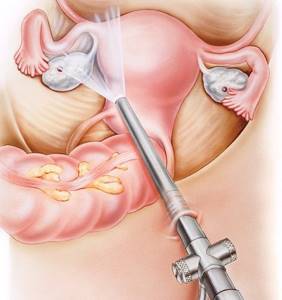If a gynecologist has diagnosed you with an ovarian cyst, do not be alarmed: as a rule, these formations are benign and do not pose a danger; surgery is not required. Often they do not need to be treated at all and disappear on their own within a few months. It is enough to periodically visit a gynecologist and undergo an ultrasound examination.
- What types of ovarian cysts are there?
- When is laparoscopy performed?
- When is laparoscopy not performed?
- Benefits of laparoscopy
- Preparation
- How is laparoscopy performed?
- Postoperative period
- Complications
- Is it possible to get pregnant after removing an ovarian cyst?
Sometimes ovarian cysts still have to be removed. Operations can be performed without an incision, through several punctures in the abdominal wall - laparoscopically. Euroonco employs expert-level gynecological surgeons who have extensive experience in performing such interventions. Come for a consultation with our specialist: he will tell you whether surgery is necessary in your case, and prescribe an examination that will help distinguish a benign neoplasm from a malignant one.
A cyst is not a specific disease. This term refers to any pathological cavity with fluid. The reasons for its formation are different. According to statistics, ovarian cysts are diagnosed in every tenth woman. They most often occur during puberty and menopause. Some girls have them from birth.
What types of ovarian cysts are there?
All ovarian cysts are divided into two large groups: functional , which occur in most cases, and pathological , which doctors have to deal with much less frequently.
Functional cysts are the result of disturbances during the menstrual cycle. Usually they do not cause complications and disappear on their own. They come in three types:
- Follicular . follicle matures in a woman’s ovaries . Normally, it should open and release the oocyte. If this does not happen and the follicle continues to grow, it turns into a cyst.
- Corpus luteum cysts . After the follicle releases the egg, it turns into a special gland - the corpus luteum . It produces the hormones estrogen and progesterone. If pregnancy does not occur, the corpus luteum atrophies. And if fluid accumulates in it, it turns into a cyst.
- Theca-luteal cysts often develop as a side effect of infertility treatment with hormonal drugs.
Pathological ovarian cysts are not associated with the menstrual cycle. They are always characterized by the appearance of “wrong” cells that should not be present normally. The most common types of pathological cysts:
- Endometrioid . This is a form of endometriosis, a condition in which endometrial tissue (the lining of the uterus) gets into unusual places and grows there. In the ovaries, it can form cavities with fluid. They often appear as “chocolate” cysts filled with dark blood.
- Dermoid cysts , or teratomas , are a special type of benign tumors made from embryonic cells. There may be different tissues inside them, for example, skin, hair, nails. Dermoid cysts become malignant very rarely.
- Cystadenomas are benign neoplasms of epithelial cells. Usually they are filled with contents of a mucous or watery nature.
For more information about malignant cysts, please visit the ovarian cancer page on our website.
How long does sick leave last?
Possible periods of sick leave after laparoscopy depend on a number of factors both on the part of the patient and on the part of the attending physician. Regarding the general time frame, the following terms of sick leave can be distinguished:
- Minimal – sick leave is issued for 1 day, namely the day of the operation, which is due to the maximum minimum of consequences arising from the operation, the absence of any intraoperative complications and the possibility of returning to work the next day;
- Medium – sick leave is issued for a maximum of five days, at the request of the patient. This period is quite enough for the postoperative sutures to tighten and not cause much discomfort to the patient with minimal physical activity;
- High – sick leave can be extended by the attending physician for up to 15 calendar days, in the case of heavy physical and mental work and the patient’s general poor health in the postoperative period;
- Maximum - sick leave is issued for a period that will be sufficient to complete the full cycle of rehabilitation measures. This sheet is issued in the event of a critical deterioration in the patient’s well-being, the presence of rather severe postoperative consequences that threaten the patient’s health, or the occurrence of injuries to internal organs.
If these periods exceed a certain general limit, namely 15 days of sick leave plus a one-time 15 days of extension of the medical commission, a sick leave after laparoscopy of an ovarian cyst is issued for a period not exceeding 10 months. This period is the maximum possible for sick leave. Despite this, these points are only an exception to the rule, since laparoscopy is one of the safest methods of surgical treatment.
Yusupov Hospital is a European multidisciplinary center, which includes not only the department of oncology, neurology and therapy, but also a surgery clinic, using advanced technologies and international standards for the quality of medical care. To find out more information about the treatment of cystic ovarian formations, make an appointment with a gynecologist by phone.
When is laparoscopy performed?
If the ovarian cyst is small, does not cause symptoms and does not look cancerous, it can be left alone. No surgery needed. The gynecologist will prescribe periodic examinations and control ultrasounds. Moreover, postmenopausal women will have to do this more often, because they have a higher risk of malignant tumors.
Are there effective medications?
In some cases, hormonal contraceptives may be helpful. They help prevent the formation of new cysts in the ovaries, but do not affect the growth of existing ones. If a woman is bothered by pain, the doctor may prescribe drugs from the group of nonsteroidal anti-inflammatory drugs (NSAIDs). But this is only symptomatic treatment. The only way to get rid of the formation is surgery.
If the cyst is “problematic,” then the doctor will definitely say that it needs to be removed. Indications for surgery:
- Large size of formation. In most cases, ovarian cysts have a diameter of 1–3 cm. Very rarely they reach 15–30 cm.
- Presence of symptoms: abdominal pain, pelvic pain, bloating, feeling of heaviness in the abdomen, heavy periods, vaginal bleeding not associated with the menstrual cycle. A large cyst can compress the intestines and bladder. This leads to problems with stool and urination.
- Suspicion of a malignant nature of the cyst - the risks are increased in postmenopausal women.
- Continued growth over 2–3 menstrual cycles.
- Pathological ovarian cyst.
What happens if the cyst is not removed?
If the doctor said that the cyst needs to be removed, then delaying the operation is primarily dangerous for postmenopausal women. They, as we have already mentioned, have a higher risk that the formation may turn out to be malignant. And with cancer, time is critical. The later treatment is started, the lower the chances that it will be successful and that remission will be achieved. The prognosis worsens and survival rate decreases.
At the Euroonko clinic you can receive treatment for ovarian cancer according to modern standards. Our doctors perform operations of any complexity; we have access to all the latest generation antitumor drugs registered in Russia. We work according to modern European, American, Israeli treatment protocols. For ovarian cancer complicated by peritoneal carcinomatosis, we use an innovative technique - hyperthermic intraperitoneal chemotherapy (HIPEC).
With benign ovarian cysts, serious complications can also occur, although they are rare. Large cysts may rupture. In this case, severe bleeding develops into the abdominal cavity, and severe abdominal pain occurs.
As the cyst grows, the risk of ovarian torsion increases. Due to compression of the blood vessels, it stops receiving blood supply, severe abdominal pain, nausea, and vomiting occur. The result may be necrosis (death) of the ovary, and it will have to be removed urgently.
If you experience symptoms such as severe abdominal pain, nausea, vomiting, or a fever of more than 38 degrees, you should immediately seek medical help.
How is the operation performed?
The operation to remove sigmoid colon cancer consists of three stages: the tumor with the adducting and efferent sections is isolated, after which the intestine is cut off and all regional lymph nodes are removed.
Then an interintestinal anastomosis is applied - connecting the end sections of the intestine, as a result of which normal passage through the intestine is restored. When forming an interintestinal anastomosis, I use endoscopic staplers made in the USA, which reduces the likelihood of complications after surgery, such as suture failure or the development of stricture.
In some cases, usually with the development of intestinal obstruction, a temporary colostomy can be formed - bringing the end of the intestine to the anterior wall of the peritoneum (unnatural anus). In this case, after 2-3 months, a reconstructive operation is planned, during which the ability to naturally move intestinal contents is restored.
Preparation
Ovarian cysts are usually detected during an ultrasound examination. In order to better assess the size, location and internal structure of the neoplasm, the condition of the ovary, they usually resort to not only transabdominal (through the abdominal wall), but also transvaginal (using a special sensor inserted into the vagina) ultrasound.
In rare cases, usually when a malignant nature of the formation is suspected, computed tomography and diagnostic laparoscopy are prescribed. of cancer antigen 125 (CA 125) in the blood testifies in favor of cancer . But this analysis is unreliable, since a positive result can be obtained for uterine fibroids, endometriosis and inflammatory processes in the pelvic organs.
Based on the examination results, the doctor advises the woman and explains which treatment tactics will be optimal in her case. If laparoscopic surgery is indicated, a date for hospitalization is set. You need to undergo a preoperative examination. It usually includes the following diagnostic methods:
- General and biochemical blood tests.
- General urine analysis.
- Blood test for hormone levels.
- Tests for infections.
- Cervical smears - cytological, flora.
- Blood clotting study.
- Determination of blood group AB0, Rh factor.
- Electrocardiography.
- X-ray of the lungs.
Laparoscopic removal of ovarian cysts is performed under general anesthesia - endotracheal anesthesia. The woman is hospitalized in the hospital the day before surgery. You can’t eat anything for 8 hours before surgery, and you can’t drink anything in the morning. Some time before anesthesia, premedication : the woman is given drugs that help her relax and calm down.
Laparoscopy for fallopian tube pathology

The main function of the fallopian tube is the delivery of a fertilized egg (zygote) to the site of implantation in the endometrium, which is carried out due to the peristalsis of the fallopian tubes and their lining villi towards the uterine cavity. If there are anatomical changes in the fallopian tubes, the entry of the fertilized egg into the uterus is difficult or impossible. Partial obstruction of the fallopian tube, the presence of obstacles in the form of adhesions lead to the “attachment” of the zygote in it and the development of an ectopic pregnancy, which can be accompanied by life-threatening internal bleeding. According to statistics, from 40 to 80% of female infertility is associated with complete obstruction of the fallopian tubes - the so-called tubo-peritoneal infertility. Therefore, one of the important points in examining a woman who has not been pregnant for more than a year is to conduct a diagnostic laparoscopy to assess the patency of the fallopian tubes. This method also makes it possible to cut adhesions and perform tubal plastic surgery, which leads to restoration of their function. In addition, during laparoscopy, other causes of infertility and gynecological diseases are excluded and, if necessary, eliminated.
Laparoscopy is a technique that allows for the diagnosis and treatment of diseases of the abdominal cavity and small pelvis with minimally invasive access through 3-4 incisions on the anterior abdominal wall 5-10 mm long, allowing the installation of special ports in the abdominal cavity. Through them, a laparoscope and instruments are inserted, making it possible to carry out not only a detailed examination of the abdominal and pelvic organs, but also a variety of surgical interventions.
A laparoscope is an optical system consisting of a wide-angle lens, an eyepiece and image transfer sections, which allow not only to transmit an image to the screen, but also to study small objects in detail due to the ability to enlarge the “picture”.
Laparoscopy is divided into two main types - diagnostic and therapeutic. It should be noted that quite often a diagnostic operation is transformed into a therapeutic one if pathological changes were discovered during the examination (for example, benign neoplasms or foci of endometriosis).
The tissue removed during this type of surgery is removed through the same small holes. Since very small incisions are made during laparoscopy, in the postoperative period the pain syndrome is much less pronounced than during an intervention accompanied by a large incision on the anterior abdominal wall.
Patients get up and walk within a few hours after the intervention, and the need for painkillers is reduced. In addition, after laparoscopy, the likelihood of adhesions is lower than after transection.
Indications for the diagnosis and treatment of fallopian tube diseases laparoscopically:
1. Infertility - laparoscopy in combination with chromalpingoscopy - injection of Indigo carmine solution into the uterine cavity and assessment of its entry into the abdominal cavity, allows you to diagnose tubo-peritoneal infertility, detect an obstacle and eliminate it. This method, along with the study of a man’s spermogram, the woman’s hormonal status, and assessment of the presence of ovulation, is one of the main methods for examining an infertile couple. It should be noted that a number of patients are inclined to non-operative methods of studying the patency of the fallopian tubes, such as hysterosalpingography and echosalpingoscopy. However, these methods, in some cases, show false results, so obstruction of the fallopian tubes according to the data is an indication for laparoscopy.
2. An adhesive process after an inflammatory disease of the pelvic organs (adnexitis, salpingoophoritis, peritonitis, etc.), leading to the formation of hydrosalpinx, in which the fallopian tube is closed by adhesions at the ends and fluid accumulates in it.
3. Acute inflammatory process leading to the formation of pyosalpinx (accumulation of pus in the fallopian tube) or tubo-ovarian abscess (purulent melting of ovarian and fallopian tube tissue).
4. Ectopic (tubal) pregnancy - in which the fertilized egg implants in the fallopian tube, growing into its wall, often leading to its rupture and life-threatening internal bleeding.
5. Sterilization - by “ligating” the fallopian tubes. This procedure is performed at the request of a woman over 35 years of age, if she has two or more children, upon the written request of the patient.
How is laparoscopy performed?
Laparoscopic intervention is performed through several punctures in the abdominal wall. Through one of them, in the navel area, a laparoscope - an instrument with a miniature video camera. It broadcasts an enlarged image onto the screen. For better visualization during surgery, the abdominal cavity is filled with gas.
Special laparoscopic instruments are inserted through additional punctures, and the cyst is removed with the help of them.
Depending on the specific situation, the scope of the operation varies:
- Often it is possible to remove only the cyst, preserving the ovary.
- In some cases, it is necessary to remove the entire ovary - to perform an oophorectomy (oophorectomy) - while the second ovary can be saved. This has to be done if a malignant tumor is suspected, or if the cyst is in an “inconvenient” location, when it is difficult to remove it separately.
- In rare cases, both ovaries may have to be removed. This operation is performed only in extreme cases, especially in women of reproductive age, since menopause occurs after removal of both sex glands. The levels of female sex hormones decrease, and this can lead to symptoms such as headaches, dizziness, nausea, hot flashes, etc.
Don't hesitate to ask your doctor questions before surgery. Ask what is the likelihood that during the operation you will have to remove both ovaries, what negative consequences this threatens, and how to cope with them.
How long to stay in the hospital
The duration of sick leave after laparoscopic surgery depends on many factors, the main ones being:
- General health of the patient;
- The need for a rehabilitation period, even taking into account the good condition of the patient;
- Possibility of undesirable consequences;
- The complexity of the operation.
In approximately 80-85% of patients, after laparoscopy they begin work a day later. This is due to the minimized invasiveness of the procedure and the rapid (compared to other operations) recovery period.
Active movements are highly recommended by doctors after laparoscopy, which promotes accelerated wound healing and prevents negative consequences in the form of postoperative abdominal adhesions.
Complications
Laparoscopic operations are associated with a low risk of complications. As after any surgical intervention, in rare cases, infection and suppuration in the area of surgical sutures and bleeding are possible. If you are concerned about severe pain, vaginal bleeding, or increased body temperature, you should immediately consult a doctor.
Adhesions may occur after surgery. Very rarely, during surgery, damage to neighboring organs (intestines, bladder) is possible.
At the Euroonko clinic, operations are performed by experienced gynecological surgeons. Our operating room is equipped with modern equipment, multifunctional laparoscopic stands from leading manufacturers. This helps to minimize risks and perform the operation as safely as possible.
After removal, the cyst may recur, in the same ovary or on the other side. Only removal of both ovaries helps to completely eliminate relapse. But such an operation leads to menopause and undesirable consequences, so it is resorted to only in extreme cases.
Postoperative period
The postoperative period is considered to be from the time of completion of surgical intervention to discharge from the hospital. After the cessation of general anesthesia, the patient may feel discomfort and moderate pain in the area of the postoperative wound. This condition is considered normal, as there is, albeit minor, damage to soft tissue.
Among the features of the early recovery period are the following:
- In the postoperative period, the woman is prescribed antibacterial and anti-inflammatory therapy in order to avoid infection. The likelihood of its occurrence still exists, despite minimal tissue damage;
- Laparoscopy - as a minimally invasive intervention allows you to maintain activity on the first day. After about 7-8 hours, the woman will be able to get up independently and use the restroom;
- In the first 5-6 hours after surgery, you are allowed to drink water. If you maintain your appetite, you can eat liquid food, such as broth;
- Laparoscopy for ovarian cysts uses gas to inflate the abdominal cavity (pneumoperitoneum). In the postoperative period, especially in asthenic women, aches in the shoulders, neck, abdomen, and legs may appear. By performing special exercises, you can quickly cope with these consequences;
- To prevent thromboembolism, anticoagulants are prescribed for therapy. Also, wearing special stockings, which are worn before and after manipulation, will help to avoid thrombosis.
Is it possible to get pregnant after removing an ovarian cyst?
You can get pregnant even with an ovarian cyst. Most often, they do not interfere with pregnancy, but they can make it difficult to conceive a child.
If during surgery only the cyst is removed or at least one ovary is left, the woman’s fertility is preserved. She may become pregnant in the future. Of course, you need to understand that reproductive function is affected not only by surgery. The ovarian reserve (the number of eggs in the ovaries - it constantly decreases with age) and concomitant diseases play a role.
Get a consultation with a doctor at the Euroonko clinic. Our doctor will tell you whether treatment is needed in your case, what type of surgery is indicated for you, and what is the likelihood that you will be able to conceive and carry a pregnancy in the future.
Book a consultation 24 hours a day
+7+7+78
Contraindications to laparoscopy
Despite a number of advantages and possibilities of laparoscopy, there are absolute and relative contraindications to its implementation. These include:
- state of shock;
- severe infectious diseases;
- bleeding disorders;
- severe diseases of the cardiovascular, respiratory systems, liver, kidneys and other organs in the stage of decompensation;
- large hernia of the anterior abdominal wall;
- infection of the anterior abdominal wall;
- tense ascites;
- pregnancy (second trimester);
- diaphragmatic hernia;
- obesity 3-4 degrees.
Types of laparoscopic operations for tubal pathology.
- diagnostic laparoscopy with chromosalpingoscopy – allows you to assess the patency of the fallopian tubes, identify and remove obstacles;
- salpingoneostomy, fimbryoplasty, fimbryolysis - various types of restoration of patency of the fallopian tube;
- adhesiolysis – separation of adhesions that prevent pregnancy;
- salpingotomy (tubotomy) - dissection of the fallopian tube in order to remove the fertilized egg from it in case of short-term ectopic pregnancy;
- salpingectomy (tubectomy) - removal of the fallopian tube, performed in the presence of hydrosalpinx (an enlarged fallopian tube filled with liquid, the ends of which are sealed on both sides), ectopic pregnancy or pyosalpinx (an enlarged fallopian tube filled with pus);
- resection of part of the fallopian tube - performed for some types of ectopic pregnancy, as well as during sterilization.










